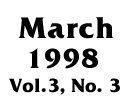



|

| |

| ||
|
|
by Justin Gary
Abstract Strategy : Sideboarding and Metagaming Sideboarding effectively embodies a key element of magic: knowledge. Over the past year the concept of 'metagaming' has grown quite a bit. Why? Because it is the logical thing to do for a game of strategy with so many options available. To look at it simply, think of a game of rock,paper,scissors. Every player has equal resources available to them, being able to use any choice (weapon) at any given time. Here, the game is almost entirely luck as each choice defeats one other and is beaten by one other. Over time a series of games would end up in a near 50/50 win ratio. Now imagine if one player had foreknowledge of what the other would throw, even for just half the time they played (e.g. one player will throw rock every other duel). Suddenly the win ratio jumps considerably as the player with knowledge can prepare for his opponent's strategy by throwing paper (even if the player threw paper every time and the opponent did not realize it, the win ration would be much better). The same principle applies to all competetive games including war and magic. Magic can be seen as a game of rock, paper, scissor with hundreds of choices (sligh, stompy, necro, etc.). In Magic, however, the choices are clearly unbalanced since many deck types can beat many others (for example: sligh beats necro and monoblue but only loses to prison with life gaining). If one deck type (such as sligh) were seen to be clearly dominating over all the other major types then many people would start to play it (if you cant beat 'em, join 'em). This, however, creates a problem. Since the deck type becomes so well known, others can prepare for its strategy and often defeat it (return to the black summer when you played necro, anti-necro, or you lost). This weakens the deck's power. The sideboard is a way for decks to prepare for opposing strategies without compromising their own initial plans. Returning this to a war analogy; if you as a defending nation learn that an invader is going to attempt to flank your position from the west with a third of its forces, then you can simply raise up a defense such as a trench or barracade that can nullify the strategy. Assuming both forces began on neutral ground, the defender now has a significant advantage (CoP Red against sligh can nullify almost all of their offense). This alteration need not be severe. By fine tuning your deck to beat certain opponents, a sideboard can be a subtle, yet effective tool. Sometimes simply adding a fourth nekrataal and a terror can be enough to ensure victory when you are already in superior positioning. Another use for the sideboard is the element of surprise. Imagine that poor defending nation who sets up their defense on the west flank, only to be attacked in full force from the south. See yourself in the position of playing against a prosbloom deck second game and seeing a sengir vampire hit the table after you boarded out your wraths, plows, and controls. The key to effective sideboarding (and deckbuilding) is knowing the field. Putting 4 glooms 4 stench of evil and 4 dystopias in your sideboard doesnt help much if you dont play against any white or green decks. Knowledge is power. Cliched, but true, especially in war. This insight can be reversed to show the importance of keeping new deck strategies secret ( remember the power of turbo stasis when it first appeared. Not only was it a new deck type but an entirely new concept of "combo magic" that has been continued by prosbloom and fruity pebbles). Another element that I feel obligated to touch on is deck synergy. No matter how good CoP Red is against sligh, your monoblack necrodeck just shouldnt use it!!! Seriously, many seemingly "powerful" sideboard cards are only good in certain scenarios (or battlefields, if you will). It is important not to disrupt your decks main synergy when sideboarding. Offensive decks cannot become citadels when four CoPs come in from the sideboard. It is important to understand how your deck works before you attempt to put together a sideboard. Many times due to time constraints this is not possible, but even the night before a tournament a player should test different sideboard card combinations in their decks as though they were in standard to ensure that synergy remains. Sideboarding and Metagaming are difficult parts of magic to master. Only with time and experience can one be able to "feel" the energy of their deck or "sense" the overall layout of the battlefield at any particular tournament. I know this sounds like spiritual mumbo-jumbo, but trust me, if you practice it, you will win.
Justin Gary
|